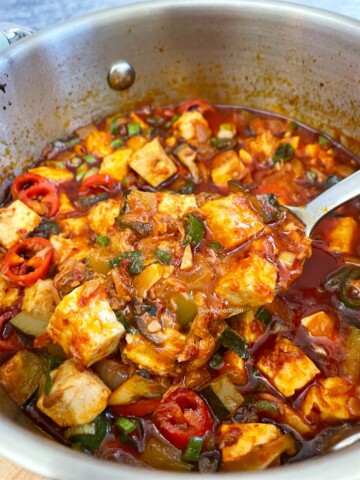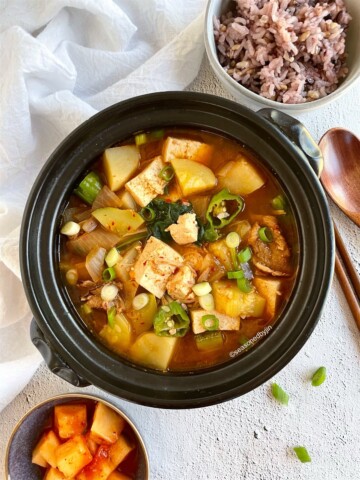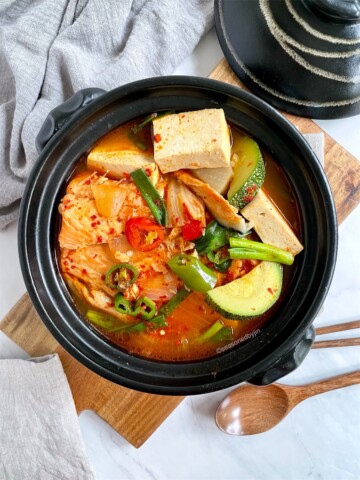Spicy Korean Squid Stew, also known as Ojingeo Jjigae, is a delicious one pot meal with tons of flavor and texture! Enjoy every bite loaded with fresh squid, chunky veggies and spicy broth!


Why this recipe works:
If you are not familiar with Korean Ojingeo Jjgae, it may be because it’s more popular as a home cooked meal. The ingredients are quite simple, healthy and only require one pot. Perfect for busy weeknights and a must try for all seafood lovers!
What are the ingredients for Korean Squid Stew?
- fresh squid: I used the frozen squid rings which came in already sliced. You can buy the whole squid that’s fresh and slice them yourself, which will give the stock a stronger flavor. I suggest leaving the skin on. However, you do have to clean it and cut them into bite size. I have cooked both ways, but when I am in a hurry, I rely on the frozen pre-sliced squid. You can buy them at Korean Markets.
- fresh vegetables: I like to use zucchinis since they pair well with squid. You can also use carrots, daikon radish and potatoes.
- korean green chili peppers: This is a must item and don’t skip it. The sliced chili peppers will elevate the overall flavors at the end. If you can’t find the Korean chili peppers, you can use jalapeños, but use moderation.
- aromatics: garlic, green onion, yellow onion
- tofu: you can use firm or soft tofu. It’s personal preference.
- Sauce ingredients: gochugaru (Red chili pepper flakes), gochujang (Korean chili paste) doenjang (Korean soybean paste), soup soy sauce (Guk ganjang), black pepper, and sugar
- water and premade seafood broth packet. These packets are typically filled with large anchovies, kelp, shiitake mushrooms, which are great for making quick dashi stocks. The brand I used also had dehydrated vegetables.
How do you make Ojingeo Jjigae
Time needed: 20 minutes
This is the way I like to make my Spicy Squid Stew. Depending on your preference, you can always modify the recipe with different types of vegetables and seasonings.
- Prep veggies, tofu, and squid. Set aside. Make spicy sauce in a small bowl and set aside.
Chop all the vegetables into bite-sized pieces, mince garlic and set aside. For ring shaped squid, divide them into halves.
- In a heated pot, pour neutral oil. Once oil is hot, add onion, garlic and white part of scallion. Stir fry in medium high heat for about 2 mins. or until fragrant.
- Add water, dashi pack into the pot and close lid. Bring water to boil then continue to boil for about 6-7 mins. When time is up, discard dashi pack.
If you don’t have the prmade packs, you can use large, dried anchovies, dry kelp and dehydrated shiitake mushrooms instead.
- Add spicy sauce and stir until dissolved. Do a taste test and add more seasoning as needed. Next combine squid, vegetables and tofu, except peppers. Boil on high heat for about 5-6 mins.
Adding the peppers at the end will give a refreshing and crunchy touch. Plus, the bright green color will give a nice pop at the end.
- Turn off heat and sprinkle green peppers. Serve hot with rice.
You can add chopped green onion if you like at this point. The stew taste best when it’s scorching hot!
Q and A
I used a frozen squid rings as pictured below. They were convinient since it’s pre-cleaned and pre-sliced. If you want stronger squid flavor, I suggest buying the fresh squid, however you will have to spend more time cleaning and cutting.
The broth will have a savory, spicy seafood flavor but not fishy and overwhelming. The stew also has lots of texture from the vegetables, tofu and tender squid. It pairs really well with plain rice and Korean side dishes. You can save the leftovers and reheated in the pot the next day. The stew will have a deeper flavor overall, however with less texture.
You can modify it by adding less gochugaru and gochujang. Afterward if it feels bit on the bland side, try adding more soup soy sauce.
I personally use soup soy sauce for most of my Korean soups and stews. The brand I use is pictured below. They tend to give more umami flavoring to the final taste. If you can’t find this where you are, I suggest using a Japanese soup soy sauce call Tsuyu.
Koreans typically consume this stew with just rice. Most Korean stews pair well with mild tasting Korean side dishes, like rolled eggs, spinach namul, and fish cake stir fry.
This stew can be stored in the fridge for 2 days. You can re-boil it in a small pot. The flavors will be even stronger; however the veggies will be much softer in texture.


Did you enjoy this Spicy Korean Stew?
If you enjoyed this dish, be sure to check out these other delicious stew recipes!
- Spicy Tofu Jjageuli with Tuna
- Spicy Salmon Stew/Yeon-eo Maeuntang
- Spicy Tofu Stew with Seafood, Haemul Sundubu Jjigae
- Korean Kimchi Stew, Kimchi Jjigae
Spicy Korean Squid Stew, Ojingeo Jjigae
Ingredients
- 1 Tbsp neutral oil
- ¼ cup small onion chopped
- 2 garlic cloves chopped
- 1 stalk green onion, white part only chopped, divided
- 1½ cup water
- 1 pack premade dashi pack
- 4-5 oz frozen squid rings, uncooked cut into halves
- ½ cup zucchini chopped
- 4.5 oz tofu block, firm cubed
- 2 Green Korean chili peppers, small sliced
spicy sauce
- 1½ Tbsp Doenjjang
- ½ Tbsp Gochujang
- ½ Tbsp Gochugaru
- 1½ Tbsp Korean soup soy sauce
- ½ tsp sugar
Instructions
- Prep veggies, tofu, and squid. Set aside.
- Make spicy sauce in a small bowl and set aside.
- In a heated pot, pour neutral oil. Once oil is hot, add onion, garlic and white part of scallion. Stir fry in medium high heat for about 2 mins. or until fragrant.
- Add water, dashi pack into the pot and close lid. Bring water to boil then continue to boil for about 6-7 mins. When time is up, discard dashi pack.
- Add spicy sauce and stir until dissolved. Do a taste test and add more seasoning as needed. Next combine squid, vegetables and tofu, except peppers. Boil on high heat for about 5-6 mins.
- Turn off heat and sprinkle peppers and scallions. Serve hot with rice.












Anonymous
So, what happen to the squid? Do you stir fry it with the onion and garlic or later with the vegetables and tofu?
Seasoned by Jin
Hello, the squid goes in with tofu and zucchini. I have updated the recipe and added a tutorial video. Hope that helps!